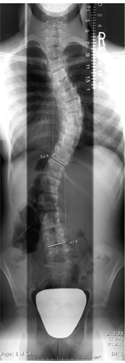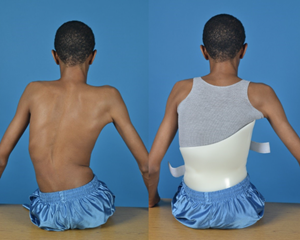
 POSNA.org
POSNA.org
Scoliosis is a curve in the spine of more than 10 degrees. If you could view your spine from the back or front it should be straight. The spine in scoliosis not only curves, but also twists. Since ribs and muscles are attached to the spine, the twist will make one side of the back look like it is sticking out more than the other. The cause of most scoliosis is not known. 2-3% of kids will have a small curve. Large Curves are 7 times more common in girls than boys and much more common in children over the age of 10 rather than younger children. Juvenile Scoliosis (kids with curves noted between the ages of 4 and 10) and Infantile Scoliosis (kids whose curves are noted before the age of 4) are much less common.
There are some types of scoliosis that are caused by other diseases (Neuromuscular scoliosis) or because the bones in the back formed differently than they were supposed to (Congenital scoliosis). Most of the time though, children are not born with curves but develop them during growth spurts in early adolescence. Small curves stop getting bigger when you stop growing. Scoliosis can be an issue because large curves (over 50 degrees) tend to continue to curve and twist even after you stop growing. On average, larger curves will increase in size about 1 degree per year for the rest of your life. A 50-degree curve in your teen years may be 100-degree curve by age 65. Those very large curves restrict the room in your chest and make it hard for the lungs to do their job.
 Figure (left). X-Ray of a patient with scoliosis. This is a standing x-ray looking from the back of the patient.
Figure (left). X-Ray of a patient with scoliosis. This is a standing x-ray looking from the back of the patient.
Scoliosis is not typically painful. It is commonly noticed by a school nurse, your parent or your pediatrician. It can cause one shoulder to look higher than the other or shorts may look tilted on your waist. The twisting can make a shoulder blade look like it is higher or sticking out more. It is common for children to grow a lot when they enter their teens, which may cause the curve to get bigger and more noticeable. Scoliosis tends to run in families and can be associated with other conditions. If you have a sibling or parent with scoliosis, you are more likely to develop scoliosis yourself.


2-3% of kids will have a small curve. Large curves are seven times more common in girls than boys and much more common in children over the age of 10 rather than younger children. Juvenile Scoliosis (kids with curves noted between the ages of 4 and 10) and Infantile Scoliosis (kids whose curves are noted before the age of 4) are much less common.
Small curves stop getting bigger when you stop growing. Scoliosis can be an issue because large curves (over 50 degrees) tend to continue to curve and twist even after you stop growing. On average, larger curves will increase in size about 1 degree per year for the rest of your life. A 50-degree curve in your teen years may be 100-degree curve by age 65.
Not typically.
If you think you have scoliosis, or if your school nurse or pediatrician thinks you should be seen, you will visit an orthopedic surgeon or practitioner who specializes in Scoliosis. You can expect to wear an examination gown for this appointment or you can prepare by bringing a sports bra and shorts with you. You will be asked questions about your back, medical history and whether anyone in your family has a curve in their spine too. The doctor will examine your skin and test your strength and reflexes to make sure all your nerves are working well. The doctor will look at your shoulders and your pelvis to check if they are level. The doctor may discover that one of your legs is shorter than the other, which may be confused as scoliosis. If one leg is shorter, the doctor will make your pelvis level by placing a small block under that foot for the exam. The doctor will ask you to bend forward to see your curve and will measure the twisting with a scoliometer – which is like a carpenter’s level.
If you do have a curve, the doctor will begin by getting X-rays of your spine, which are special pictures that look at your bones. Occasionally the pattern of the curve or features of your skin or nerve exam will require additional testing such as an MRI. If you have a curve, which measures more than 10 degrees on your X-ray, and you are still growing, your doctor may recommend follow up to take more X-rays to see if your curve is staying the same or getting bigger over time.
Treatment of scoliosis involves careful consideration of many factors including your age, how much growing you have left to do, the size of your curve, the shape and location of your curve and how much it has progressed since the last visit. In general, the types of treatment for scoliosis are:
Observation - Observation is appropriate in general for growing children with curves less than 20-25 degrees. You can plan to follow up with your orthopedic surgeon or provider every 4 to 6 months with X-rays to see if your curve is getting bigger or staying the same. There is nothing you can do to make the curve better or keep the curve from getting bigger between appointments. Scoliosis is not painful. If you have back pain – you should see your pediatrician and treat your pain as a separate issue. There are many physical therapy programs being offered to treat scoliosis but there is no strong evidence that this works alone to correct scoliosis. It is always a good idea to stay physically fit. Your Scoliosis is no reason not to participate in any sport you want.
Bracing - Bracing is often recommended for children that are still growing and have a large curve (over 20 or 25 degrees), especially if their curve has gotten bigger over time. The goal of the brace is to hold the curve where it is but not to correct it. The brace is usually worn for 18-22 hours a day. A well-fitting brace should be comfortable and well tolerated. You may need to return to the brace shop one or two times to adjust the brace. The brace is important because it gives you a good chance of avoiding surgery. It is not easy to wear a body brace all day long so you should remember that you have about 4 hours a day that you can come out of the brace to do all the things you want to do, including swimming, sports and dance. There are other brace types available but not every orthopedist uses the same ones, so discuss options with your surgeon.
Surgery - Surgery is reserved for large curves over 50 degrees. This occurs in less than 0.1% of the population. In this case, the brace will not work and surgery is usually recommended. The goal of the surgery is to trade a curving spine for a stiff straight one by fusing it into a solid block of bone. Your orthopedic surgeon will do the surgery. While you are asleep, he or she will make an incision on your back for the full length of the curve. Your surgeon will carefully move the muscles off your spine and then put screws or hooks at certain points in the bones along the spine on both sides. Those screws and hooks will help pull the spine over to two rods, which hold your spine straight. You will be in the hospital for several days and out of school for a few weeks. You will need several months for the muscles and bones to fully recover. When you are fully recovered and the spine is fully healed, you will return to most of the activities that you did before, including running and many sports. This will depend on the type of surgery and should be discussed with your surgeon.